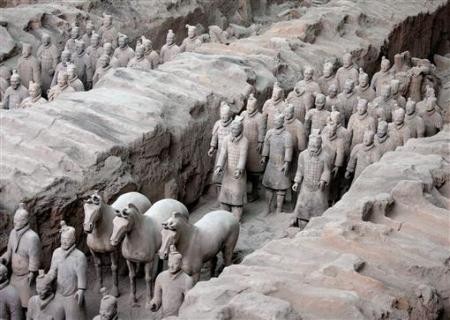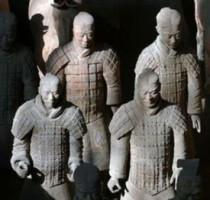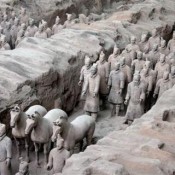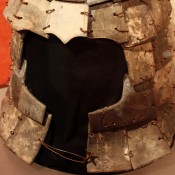A reader of East Asian archaeology at University of London asserts that Greek art was the inspiration for the 8,000 terracotta warriors that guard the mausoleum of China’s first emperor, Qin Shi Huangdi.
Lukas Nickel, reader at UCL, supports that recently translated ancient texts indicate early contact between China and Greece. According to these texts, the first emperor copied 12 huge statues that appeared in western China more than 2,200 years ago. The story is a fantastic tale involving “giant” statues “appearing” in the far west of China but probably conveys memories of real facts that took place during Qin’s lifetime. In the text, recorded by Yan Shigu, who lived around 1,400 years agoand used an earlier written source, it is said that in the “26th Year of the Emperor, when he first brought together all-under-heaven, divided the principalities into provinces and districts, and unified the weights and measures, [these] giants appeared in Lintao …”. The statues are described as clad in “foreign robes”.
The First Emperor duplicated these statues despite a “heavenly taboo” that “he who recklessly follows foreign models will encounter disaster,” wrote Ban Gu, a historian who lived almost 2,000 years ago. Ban worked for the dynasty that had overthrown the First Emperor’s dynasty and, as such, tried to cast him in a negative light.
It is true that large statues were not present in China before this time. According to Prof. Nickel,the idea to construct such sculptures “copying foreign modes”, was influenced by the conquest of Alexander the Great. Although the duplicates do not survive, ancient writers left records of them behind, as they were displayed publicly in front of the First Emperor’s palace, Nickel told LiveScience.
Link to the Teracotta Warriors
Meanwhile, the Terracotta Warriors, though they survive to present day, were buried in pits out of sight and, as such, no record of them survives today. Despite this absence, Nickel can see connections with Greek art, as the Warriors and other groups of statues from the Emperor’s funerary pits display characteristics of the human body achieved only by Greek art since then.
A few dozen statues of half-naked acrobats and dancers were also found in separate pits near the First Emperor’s mausoleum. “Here the sculptors attempted to render a bone structure, muscles and sinews to depict a person in movement,” Nickel writes in his paper. “This comes close to an understanding of the human body that was employed at the time only in Hellenistic (Greek influenced) Europe and Asia.”
He argues that creating this sort of realistic sculpture is not something that a sculptor could learn without some practice, taking the ancient Greeks centuries to master it. “The creation of a believable human body preoccupied generations of Greek sculptors. It was a complex artistic and intellectual process that did not happen overnight,” Nickel writes.
Taboo
After Qin, the life-size statue building stops. “Disaster” happens when foreign models are followed recklessly, wrote Ban Gu, and the Chinese seem to have believed in that. To the ancient Chinese, the 12 giantstatues clad in foreign robes, and the Terracotta Warriors buried in pits, would have represented something unusual and foreign, Nickel said. “Over all of Chinese early history sculpture did play only a minor role,” Nickel told LiveScience in the interview. “To the Chinese it must have looked quite alien,” he added. The Han rulers, wishing to repudiate the First Emperor and his foreign tastes, may have simply decided not to create life-sizeor largersculptures of their own”.





